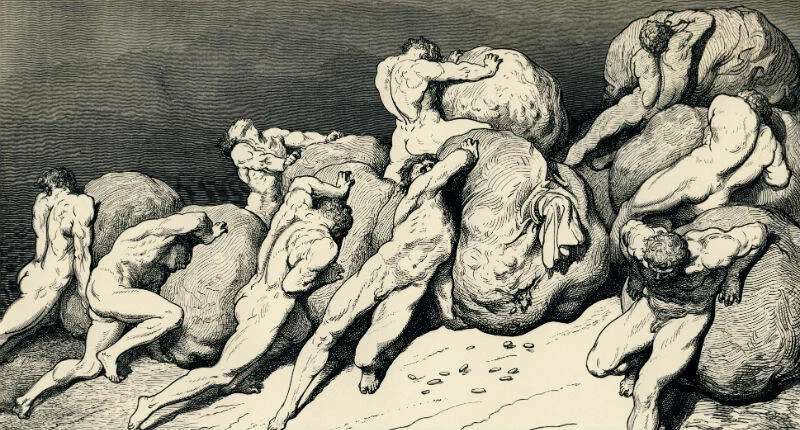If you’re the studious type and feel inspired by my previous post or for your own reasons to do a celebratory 750th anniversary reading of Dante’s Divine Comedy, you might quickly find yourself awash in translations and guides and biographies and not know quite where to start.
I am a scholar of literature, but I also value the pleasures of reading, and I don’t see the value in weighing yourself down with expectations of becoming an expert. For those of you who feel that pressure, it may be useful to hear a PhD in English give you permission to just dive right into something.
I still often read widely, anyway, chasing an elusive expertise. That doesn’t mean it’s necessary for anyone else, but it does mean that I can get a feel for the lay of the scholarly land well enough to help other readers read more efficiently, and my intention here is to offer some tips that I have personally found useful for enjoying Dante. One way or another, your reading of Dante will be mediated, anyway, by translators and editors and biographers; there’s no “pure” Dante in that sense. But the poem itself presumes that we cannot accomplish the most important things on our own—the pilgrim has guides through each stage of the Afterlife—so we needn’t feel vexed at the multiple voices that help us through the Commedia. Rather, we just want to choose useful and reliable ones. My recommendations in what follows are not meant to be definitive or exhaustive so much as trustworthy; you are encouraged to explore others as you are inclined.
Talking the Talk
The first thing you may want to know is that while we think of The Divine Comedy as three books, Dante himself thought of it as one long poem divided into three parts which he called canticles. This is worth keeping in mind because many people who read any Dante in school only read Inferno, but that doesn’t give you the whole perspective of the poem, though it does point toward its conclusion.
Each canticle is divided into 33 cantos (3 is a major structural device). Technically, Inferno has 34 cantos, making the total a nice round 100. The first canto of Inferno is often treated as a kind of introduction or prologue to the whole.
Each canto runs around 150 lines in length and is written in terza rima. This is an interlocking rhyme scheme whereby lines 1 and 3 of the tercet rhyme, while line 2 sets the rhyme for lines 1 and 3 of the next tercet, and each canto ends with a single or fourth line.: aba bcb cdc . . . xyx yzyz. This is an unforgiving rhyme scheme for English, which we’ll address below regarding translations.
Dante simply called the whole poem his Comedy; we started calling it The Divine Comedy some time after his death. You’ll see people more or less freely alternating between these titles depending on how “scholarly” they want to sound, sometimes even preferring the Italian Commedia. On the other hand, people generally use the Italian names for each canticle—Inferno, Purgatorio, Paradiso—rather than their English equivalents, Hell, Purgatory, and Heaven/Paradise. In other words, don’t sweat titles; just be aware that there are a couple ways to refer to each book or place. I’ll often use the Italian for the simple pleasure of saying them.
On the Vernacular Language: Picking a Translation
I have had a couple bad experiences with translations that turned me off of a book, only to later discover a better translation that helped me fall in love with the same book, so I do get kind of vexed about choosing a translation. Since I’m not a scholar of medieval Italian, I can’t much speak to accuracy, but when choosing my version(s) of the Commedia I looked for a combination of a pleasing read and critical respectability.
In translating poetry, sound and image are sometimes more important than literalism; it has to be pleasing and evocative in the way of the original. I have enough Spanish and a smattering of Italian, so I like a facing-page edition. For passages or lines I find striking, I’ll often peek at the original to see how close the translation keeps. Google Translate can help when I’m out of my depth. But if you’re not likely to pull out a screen while you’re reading, you might find it comforting to know that I’m often impressed with how well the translator preserves the sense of the original.
If the pleasure of reading matters to you, it’s probably worth going to the Barnes & Noble or your local library and comparing a passage from a couple translations. I’m afraid the Internet won’t be much help; I never got far from googling “best translation of Dante.”
The first time I read through the Commedia I used Mandelbaum’s translation and really enjoyed it. For my reading journal this time around, I’m planning to use Robert Pinsky’s translation of Inferno, W.S. Merwin’s Purgatorio, and Anthony Esolen’s Paradiso. By mixing the voice up, I’m potentially sacrificing a sense of the unity of the poem, but I believe it will also help to enrich my sense of its music and imagery. I also considered Henry Wadsworth Longfellow’s 19th century translation, which was standard for a long time and still reads quite well. He tends to fight harder than contemporary translators to maintain the rhythm of the line, and he often opts for an antiquated diction, but that can sometimes give him a compression and sound reminiscent of Shakespeare. His notes are also fascinating, often including whole works or extensive excerpts to provide the reader with ancient context.
Volumes and Volume
Sometimes we scholarly types can get worked up about how many other books to read or even how much to read at a time. I often read multiple books at the same time, especially when one of those books is poetry. Poetry demands one’s time and attention to really enjoy it, so sometimes it’s too noisy or I’m too tired to read Dante but could track with a biography or some nonfiction. So if you want to pick up a biography or a critical work, I recommend reading it alongside the Commedia rather than partitioning them out—but read in whatever way you feel most comfortable.
Also, don’t sweat how long it may take you to get through any given canto or canticle. Poe argued that the effect of poetry depended so much on compression that there was no such thing as a long poem. To read an epic like Paradise Lost meant, to him, breaking down the whole into much smaller parts defined by the length of a given period of reading, The Comedy works similarly. Sometimes you’ll find yourself clipping along reading many cantos together, other times a single canto may keep you going over and over it.
Googling Dante: Web Resources
Most editions will have endnotes to help you figure out specific references and allusions, and Pinsky’s Inferno has brief critical intros to many cantos, so you probably won’t feel the need to go online for more help. There are a few universities with Dante Project websites, but they are often meant to be scholarly resources and are rarely very user friendly. The best site I’ve found for poking around is U Texas’s Danteworlds.
For more comprehensive image collections, you can start at World of Dante. Barry Moser’s illustrations are perhaps the best, but you may only be able to find them in random places online or in the Mandelbaum edition. For something unexpected and perhaps on the sensational side of things, check out the Lego Inferno.
The Bottom Line: Read to Enjoy
Look, this is a late medieval poem that’s over 700 years old; give yourself the freedom to read at your own pace and to try to squeeze what you can out of it. I strongly encourage slow reading. If you find yourself drifting, go back a few lines and start again. Take time to really visualize what Dante describes. If you can’t get there, set it aside for a while and take it up again later—just don’t give up. You wouldn’t want to get stuck in Hell and miss the beauties of Paradise.








Comments
Be the first one to make a comment!